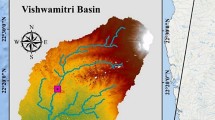Abstract
A challenging issue in optimal allocating water resources is uncertainty in parameters of a model. In this paper, a fuzzy multi-objective model was proposed to maximize the economic benefits of consumers and to optimize the allocation of surface and groundwater resources used for optimal cropping pattern. In the proposed model, three objective functions were optimizing farmer’s maximum net profit, groundwater stability and maximizing the reliability of water supply considering uncertainties in water resources and economic parameters in a basin. The optimal Pareto trade-off curves extracted using Non-dominated Sorting Genetic Algorithm- II. The best point on the Pareto trade-off curves was determined by using five decision-making approaches which combined by Breda aggregation method. Then, analyzing the credibility level of the optimization parameters and nonlinearity condition of objective functions revealed that by non-linearization of objective functions and increasing the fuzziness of the water demand and economic parameters, the model achieves more desirable values. Having been applied under uncertain conditions of objective functions and the input parameters, the results indicate an average increase of 17% and 54% in the allocation of agriculture and urban sectors, respectively. According to the annually optimal allocation results, the groundwater resources show higher sensitivity rather than surface water resources to the uncertainties in the parameters. Moreover, the optimal operation policies are more efficient than the deterministic model Consequently, the suggested model can facilitate optimizing water resources allocation policies, providing the optimal cropping pattern under uncertainty conditions, and can be used for the similar uncertain condition in other basins.






Similar content being viewed by others
Change history
11 December 2019
The original version of this article unfortunately contains mistakes introduced during the publishing process. The mistakes and corrections are described in the following list
11 December 2019
The original version of this article unfortunately contains mistakes introduced during the publishing process. The mistakes and corrections are described in the following list
References
Abolpour B, Javan M (2007) Optimization model for allocating water in a river basin during a drought. J Irrig Drain Eng 133:559–572
Azarnivand A, Banihabib ME (2017) A multi-level strategic group decision making for understanding and analysis of sustainable watershed planning in response to environmental perplexities. Group Decis Negot 26:629–648
Banihabib ME, Hashemi F, Shabestari MH (2017) A framework for sustainable strategic planning of water demand and supply in arid regions. Sustain Dev 25:254–266
Banihabib ME, Shabestari MH (2017) Fuzzy Hybrid MCDM Model for Ranking the Agricultural Water Demand Management Strategies in Arid Areas. Water Resour Manag 31:495–513
Bozdağ A (2015) Combining AHP with GIS for assessment of irrigation water quality in Çumra irrigation district (Konya), Central Anatolia, Turkey. Environ Earth Sci 73:8217–8236
Bozorg-Haddad O, Azarnivand A, Hosseini-Moghari S-M, Loáiciga HA (2016) Development of a comparative multiple criteria framework for ranking pareto optimal solutions of a multiobjective reservoir operation problem. J Irrig Drain Eng 142:04016019
Deb K, Agrawal S, Pratap A, Meyarivan T (2000) A fast elitist non-dominated sorting genetic algorithm for multi-objective optimization: NSGA-II. In: International Conference on Parallel Problem Solving From Nature. Springer, pp 849–858
Kishor A, Yadav SP, Kumar S (2009) Interactive fuzzy multiobjective reliability optimization using NSGA-II. Opsearch 46:214
Li Z, Huang G, Zhang Y, Li Y (2013) Inexact two-stage stochastic credibility constrained programming for water quality management. Resour Conserv Recycl 73:122–132
Liu J, Li Y, Huang GH (2013) Mathematical modeling for water quality management under interval and fuzzy uncertainties. J Appl Math 2013
Lu H-W, Huang GH, He L (2010) Development of an interval-valued fuzzy linear-programming method based on infinite α-cuts for water resources management. Environ Model Softw 25:354–361
Ministry of energy (2010a) Updating the IRAN water master plan, Urmia lake watershed studies reports, Surfacewater resources studies report
Ministry of energy (2010b) Updating the IRAN water master plan, Urmia lake watershed studies reports, Agricultural consumption studies report
Niu G, Li Y, Huang G, Liu J, Fan Y (2016) Crop planning and water resource allocation for sustainable development of an irrigation region in China under multiple uncertainties. Agric Water Manag 166:53–69
Rosegrant MW, Cai X, Cline SA (2002) World water and food to 2025: dealing with scarcity. Intl Food Policy Res Inst
Sahoo B, Lohani AK, Sahu RK (2006) Fuzzy multiobjective and linear programming based management models for optimal land-water-crop system planning. Water Resour Manag 20:931–948
Sasikumar K, Mujumdar P (1998) Fuzzy optimization model for water quality management of a river system. J Water Resour Plan Manag 124:79–88
Tabari MMR (2015) Conjunctive use management under uncertainty conditions in aquifer parameters. Water Resour Manag 29:2967–2986
Yang G, Guo P, Huo L, Ren C (2015) Optimization of the irrigation water resources for Shijin irrigation district in north China. Agric Water Manag 158:82–98
Yousefi M, Banihabib ME, Soltani J, Roozbahani A (2018) Multi-objective particle swarm optimization model for conjunctive use of treated wastewater and groundwater. Agric Water Manag 208:224–231
Zeng X, Kang S, Li F, Zhang L, Guo P (2010) Fuzzy multi-objective linear programming applying to crop area planning. Agric Water Manag 98:134–142
Author information
Authors and Affiliations
Corresponding author
Ethics declarations
Conflict of Interest
None.
Additional information
Publisher’s Note
Springer Nature remains neutral with regard to jurisdictional claims in published maps and institutional affiliations.
Rights and permissions
About this article
Cite this article
Banihabib, M.E., Mohammad Rezapour Tabari, M. & Mohammad Rezapour Tabari, M. Development of a Fuzzy Multi-Objective Heuristic Model for Optimum Water Allocation. Water Resour Manage 33, 3673–3689 (2019). https://doi.org/10.1007/s11269-019-02323-7
Received:
Accepted:
Published:
Issue Date:
DOI: https://doi.org/10.1007/s11269-019-02323-7




